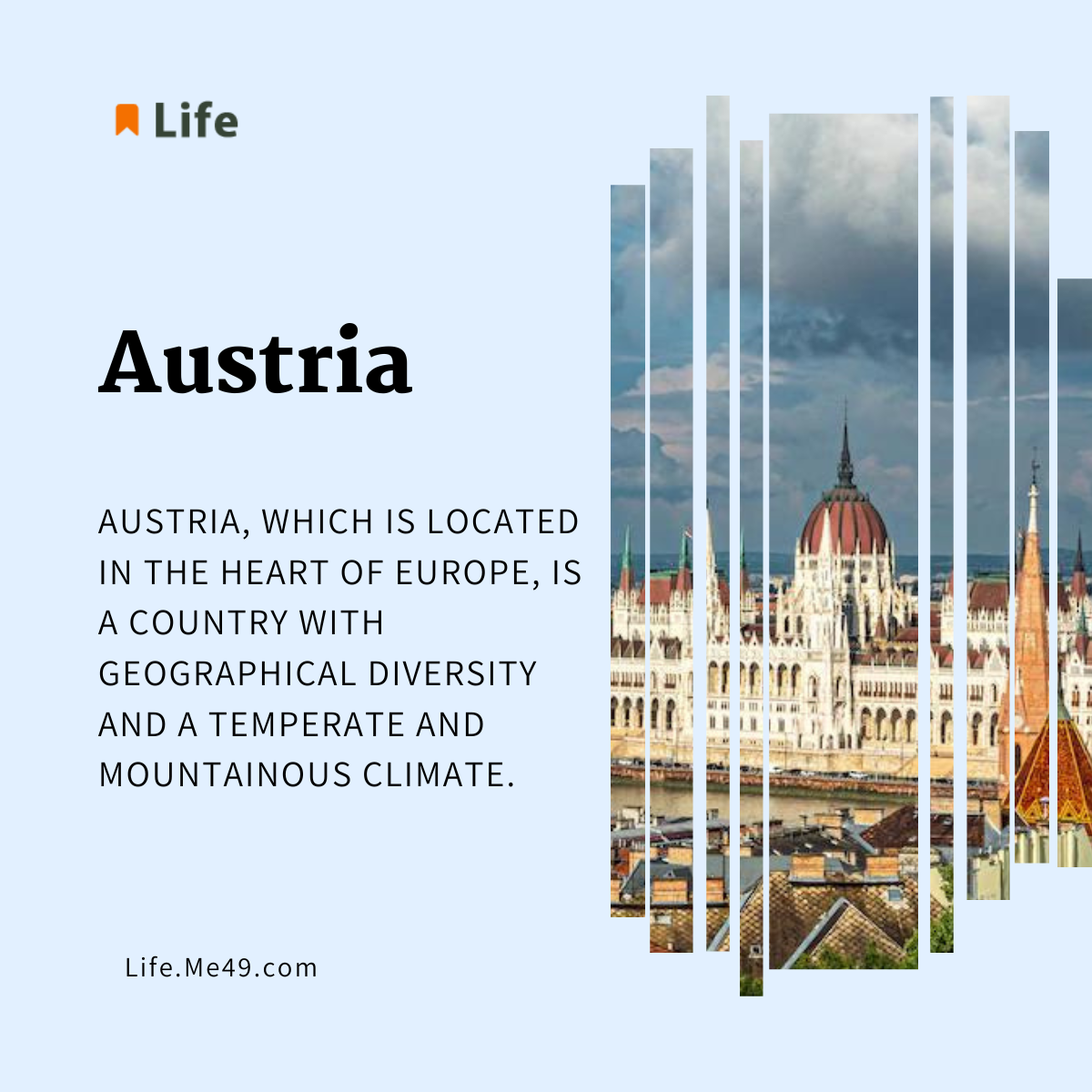Introducing Austria; About Austria
Austria, nestled in the heart of Europe, is a landlocked country covering an area of 83,878 square kilometers (32,385 sq mi).
Its geographical diversity gifts it with a temperate and alpine climate.
The primary language spoken here is German, serving as the official language of the nation.
However
Austria is a mosaic of cultures and languages, with Croatian, Hungarian, and Slovenian being recognized as official regional languages.
The vibrant and populous capital, Vienna, boasts a population of over 1.9 million residents.
Austria’s economic prowess is striking, ranking it among the world’s wealthiest nations.
With a remarkable GDP per capita of $28,502.77, it consistently provides its citizens with a high standard of living.
Vienna, the jewel in Austria’s crown, consistently secures its place at the pinnacle of global rankings for quality of life, making it a highly sought-after destination for residents and visitors alike.
Geographical location of Austria
Austria’s strategic location in the heart of Europe makes it an ideal hub for exploring neighboring countries.
This central European gem beckons expatriates with its unique charm and opportunities for adventure.
It shares its borders with an array of European nations, creating a gateway to the continent. To the north, Austria is bordered by the Czech Republic and Germany, while to the east, it shares boundaries with Slovakia and Hungary.
To the south, you will find Slovenia and Italy, and to the west it is bordered by Switzerland and Liechtenstein.
The country’s political structure is that of a federal republic, comprising nine distinct states:
Burgenland, Carinthia, Lower Austria, Upper Austria, Salzburg, Styria, Tyrol, Vorarlberg, and the capital city of Vienna.
Each of these states contributes to Austria’s rich tapestry of culture, landscapes, and experiences, inviting both residents and travelers to explore its diverse offerings.
Capital of Austria and important cities of Austria
Below is information about some of the famous cities in Austria:
Vienna
Vienna, the grandeur of Austria and its largest city, is a thriving metropolis with a population of 1,921,153, according to the latest 2022 statistics.
It’s no surprise that Vienna consistently ranks among the world’s top cities, thanks to its exceptional quality of life.
This city is a haven for those seeking opportunities, as it boasts a robust job market and high income levels.
The residents of Vienna enjoy a wealth of health and welfare services, efficient public transportation, top-notch educational institutions, and quality housing options.
What truly sets Vienna apart is its strategic location.
With its well-connected train networks, Vienna residents can embark on a short journey to explore other European capitals like Prague, Berlin, Bratislava, and Budapest, making weekend getaways to these exciting destinations a breeze.
Vienna’s blend of cultural richness, economic prosperity, and accessibility makes it a truly remarkable place to call home or visit.
Graz
Graz, home to a substantial student population, owes its academic reputation to its renowned universities.
While it may not match Vienna in international fame, Graz remains an attractive choice for expats.
As Austria’s IT hub with a flourishing startup scene, the city offers ample career prospects in these industries.
Moreover, the cost of living in Graz is notably more budget-friendly than in Vienna.
Linz
Linz, a hub for numerous international companies, holds appeal for expats seeking career opportunities.
Despite an efficient public transportation system, bicycles are a popular mode of local transport.
Linz’s proximity to the Czech Republic and Germany also makes it a convenient starting point for holiday trips to Prague and Berlin.
Salzburg
Salzburg, renowned for its musical and cultural heritage, owes its fame to the legendary composer Mozart.
Despite its small size, the city boasts a substantial immigrant community, driven by a plethora of job opportunities.
Salzburg serves as the headquarters for several renowned international brands, making it effortless to secure English-speaking employment.
Innsbruck
Innsbruck, nestled amidst the stunning Alps, is a coveted destination for winter sports enthusiasts, offering skiing and snowboarding adventures.
The region’s picturesque landscapes also make it a captivating spot for springtime strolls.
As a vibrant university city, Innsbruck hosts multiple universities, attracting a youthful population and a range of employment opportunities that don’t necessarily require fluency in the German language.
Demographics of Austria
As of the latest 2022 statistics, Austria has a population of 9,062,934 people, resulting in a population density of 105 individuals per square kilometer.
The population growth rate in Austria for 2022 stood at 0.67%. Projections indicate a significant shift in the demographic landscape, with the average age of the Austrian population expected to rise dramatically, from 5.43 years in 2020 to 47 years by 2060.
Austria has witnessed the emergence of various new ethnic groups in recent years, primarily due to immigration.
Notably, more than 300,000 individuals from the former Yugoslavia migrated to Austria during and after the war, along with another 300,000 from Turkey.
Many of these immigrants have acquired Austrian citizenship, and they now constitute a significant part of the Austrian population.
Presently, there are 185,000 Turks, including Turkish Kurds, residing in Austria, accounting for 2.2% of the population.
They represent the third-largest ethnic minority, following Serbs and Germans, who make up 7.2% of the population.
The influx of immigrants has made Austria a diverse and multicultural society, with a considerable portion of non-Austrian residents.
In 2020, approximately 17% of Austria’s total population held foreign citizenship.
History, culture and civilization of Austria
Austria’s historical roots can be traced back to the days of the Roman Empire, where a Celtic kingdom was conquered around 15 BC, eventually becoming the Roman province of Noricum in the 1st century AD, encompassing much of present-day Austria.
In 788 AD, Charlemagne, the Frankish king, conquered the region and introduced Christianity.
Under the rule of the native Habsburg dynasty, Austria rose to prominence as one of Europe’s major powers.
In 1867, the Austrian Empire transformed into Austria-Hungary.
The Austro-Hungarian Empire met its demise in 1918, marking the end of World War I.
The first Austrian Republic was established in 1919.
However
In 1938, Austria was occupied and annexed by Nazi Germany, a dark period that lasted until the conclusion of World War II in 1945.
Austria was subsequently occupied by the Allies, leading to the restoration of its democratic constitution.
In 1955, the Austrian State Treaty came into effect, re-establishing Austria as an independent nation and formally ending the occupation.
Austria’s National Day, celebrated on October 26, holds immense significance as it commemorates the end of the Allied occupation in 1955 and the passing of a law by Austria’s parliament, solidifying the country’s commitment to permanent neutrality.
Austria boasts a rich cultural heritage that spans centuries, influencing numerous books and films.
Its culture is closely aligned with German culture, characterized by a degree of formality, polite manners, and a strong emphasis on personal grooming and punctuality.
Austria’s cultural contributions are celebrated worldwide, making it a nation of enduring influence and significance.
The language and religion of Austrian people
Austria primarily employs Standard Austrian German as its official language.
While there are subtle distinctions between Austrian German and standard German, they share many similarities.
In major cities and popular tourist destinations, English is frequently spoken and understood.
In areas frequented by tourists, the linguistic landscape becomes more diverse.
Due to the increasing immigrant population from various regions, you may encounter a range of Eastern European languages such as Croatian, Hungarian, and Polish, along with Turkish and Arabic.
This linguistic diversity reflects Austria’s multicultural atmosphere, enriching the experience for both visitors and residents.
Religion holds a significant place in Austrian society, with over 75% of the population identifying as Roman Catholic.
However
It’s worth noting that these figures have experienced a decline in the latter half of the 20th century.
In contrast, Austria has seen a growth in its Muslim population, primarily due to increased immigration from countries like Turkey and Bosnia and Herzegovina.
This demographic shift reflects Austria’s evolving religious landscape as it becomes more diverse and multicultural.
The type of government and political structure of Austria
Austria operates as a democratic republic, with a government consisting of elected officials.
The Chancellor assumes the role of the head of government, overseeing the executive branch and working in conjunction with the parliament.
Political appointments, including parliament members, are elected through a democratic process, and Austria currently has five political parties in power.
These parties include the People’s Party of Austria, the Social Democratic Party of Austria, the Freedom Party of Austria, the Greens, and the NEOs (New Austria and Liberal Association).
In Austria, the right to vote is extended to all citizens aged 16 and above, including some European Union citizens residing in the country.
Austria actively engages in international politics, with participation in the European Union and the United Nations, as well as NATO membership for the sake of peace and adherence to the Treaty on the Prohibition of Nuclear Weapons.
Austria’s prominent global presence has led to the establishment of numerous international organizations’ headquarters in Vienna, including the Secretariat of the Organization for Security and Cooperation in Europe, the International Atomic Energy Agency, the United Nations Industrial Development Organization, and the Comprehensive Test Ban Treaty Organization.
Vienna serves as a hub for diplomacy and international cooperation on the world stage.
Economy and work in Austria
Economically, Austria can be likened to a compact yet robust powerhouse.
Despite the relative scarcity of natural resources like iron ore, Austria stands as an industrial nation with diverse sectors.
Key industries in the country encompass agriculture, luxury goods, engineering, steel production, chemicals, and tourism.
Austria boasts one of the world’s highest GDP per capita rates, with an average per capita income of $33,541 US dollars, just slightly below the global average among OECD nations.
Interestingly, the cost of living in Austria is generally reasonable, especially when compared to major European capitals like London and Paris, even though cities like Vienna and Innsbruck may have slightly higher living expenses.
Austria’s commitment to high living standards is evident in its robust social support system.
The Austrian government provides substantial assistance for housing, healthcare, childcare, and other public services, contributing to a strong quality of life.
An interesting employment perk in Austria is the annual payment of salaries over fourteen months, with the thirteenth and fourteenth months serving as bonuses, often used for Christmas shopping and New Year holidays.
In 2020, the average annual gross income in Austria was €29,458, as reported by the Austrian Audit Office, translating to an average monthly gross salary of approximately €2,104.
These figures reflect Austria’s stability and prosperity, making it an attractive destination for both residents and expatriates.
Income tax in Austria
In Austria, income tax, known as Einkommensteuer, is levied on individuals throughout the year based on their income.
All residents of Austria are obligated to pay taxes. Non-residents working in Austria, on the other hand, are subject to limited taxation, only on the income they earn within Austria, without additional taxes.
Austria’s social security tax is a mandatory component of the employment tax, covering health insurance, pension insurance, unemployment insurance, and accident insurance.
These contributions are calculated as a percentage of the total monthly income and are shared between the employee and the employer.
The specific amount of tax paid depends on the income level in Austria. Below is a table outlining the income tax rates based on annual income in Austria:
| Row | Annual income | tax rate |
| 1 | Up to 11,000 euros | 0% |
| 2 | 11,000 euros – 18,000 euros | 5% |
| 3 | 18,000 euros – 31,000 euros | 35% |
| 4 | 31,000 euros – 60,000 euros | 42% |
| 5 | 60,000 euros – 90,000 euros | 48% |
| 6 | 90000 euros – 10000 euros | 50% |
| 7 | More than 1000000 euros | 55% |
Tax deductions can be applied for medical, hospital, dental and childcare expenses.
For this purpose, a person can fill out an application entitled ArbeitnehmerInnenveranlagung at the tax office.
Austrian education system
The Austrian education system mandates 9 years of compulsory education for students, spanning from the ages of 6 to 15.
The majority of students opt for public schools, which offer education free of charge.
Nevertheless, Austria also boasts numerous high-quality private and international schools, although attendance at these institutions typically involves substantial tuition fees.
Austria’s universities enjoy a strong reputation in Europe, with the University of Vienna ranking as one of the country’s top institutions.
Notably, studying at Austrian public universities is tuition-free, making higher education accessible to a broad range of students.
The country is home to over 600 universities, both public and private, although some are relatively small and specialize in particular fields like arts or business.
This diversity of educational options underscores Austria’s commitment to providing a well-rounded education system that caters to various academic interests and career paths.
Austrian tourist attractions
Austria’s allure lies in its breathtaking mountainous landscapes, historic treasures, and vibrant entertainment options.
Here are some of the country’s most famous attractions:
- BadGastein:
A charming mountain town renowned for its hot springs, offering relaxation and rejuvenation in a stunning alpine setting. - Wörthersee:
Carinthia’s largest lake, perfect for swimming, water sports, and relaxation along its picturesque shores. - Zillertal Alps:
A year-round destination nestled on the Italian border, offering both skiing in the winter and hiking in the summer amidst the stunning Zillertal Alps. - Zell am See:
A mountain city surrounded by pristine lakes and verdant meadows, providing opportunities for outdoor activities and breathtaking scenery. - Hallstatt:
This captivating and Instagram-famous town is nestled between a crystal-clear lake and towering mountains, offering a glimpse into Austria’s picturesque beauty. - Feldkirch:
An old town with cobblestone streets and a blend of Swiss, French, and German influences, where you can enjoy bars, eateries, and historical charm.
Austria’s diverse landscapes and cultural heritage make it a must-visit destination for travelers seeking both natural beauty and rich history.
FAQs
What is the name of the best university in Austria?
The best university in Austria is the University of Vienna.
What is the unemployment rate in Austria?
The unemployment rate in Austria varies over time, but is generally low, at 7% in 2021, according to the latest figures.
What is the population in the largest city of Austria?
Vienna is the largest city in Austria with a population of approximately 1.9 million.








